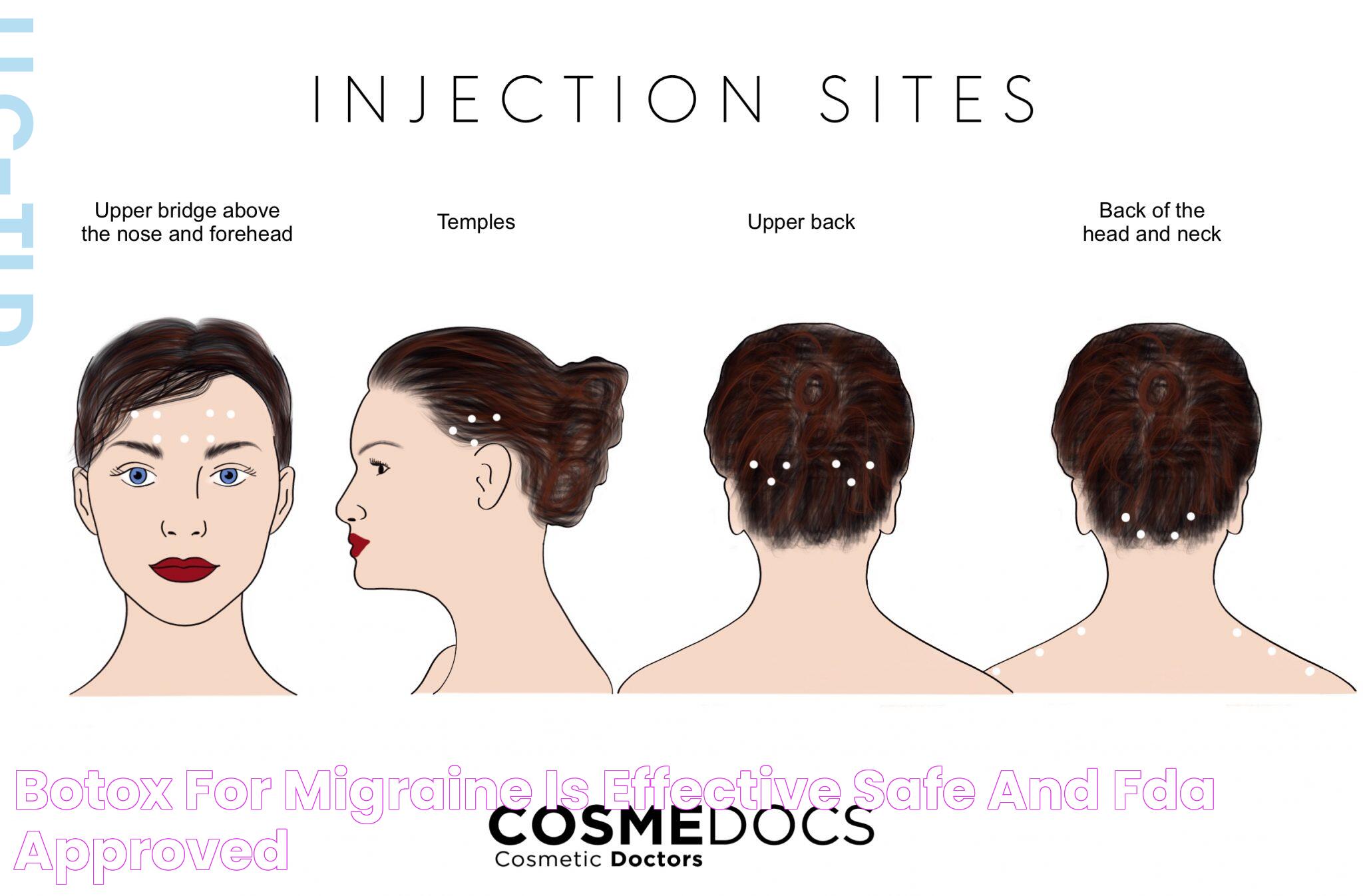Migraines can be debilitating, affecting one's quality of life and daily activities. While there are various treatments available, Botox has emerged as a promising option for many sufferers. Understanding where they inject Botox for migraines can provide insight into how this treatment works and why it's effective. In this comprehensive guide, we'll delve into the intricacies of Botox injections for migraines, exploring their effectiveness, procedure, and potential benefits.
Botox, commonly known for its cosmetic applications, has been approved for treating chronic migraines. This treatment is specifically designed for individuals who experience headaches for more than 15 days a month, with each headache lasting four hours or more. The injection process involves strategically placing Botox in specific areas to target and alleviate migraine symptoms, offering relief to those who have not found success with other treatments.
In this article, we'll explore the various aspects of using Botox for migraine relief, including where they inject Botox for migraines, the science behind its effectiveness, potential side effects, and frequently asked questions. Whether you're considering Botox as a treatment option or simply seeking more information, this guide aims to provide you with valuable insights and a better understanding of this innovative approach.
Read also:Benefits And Uses Of Mielle Rosemary Mint Hair Care
Table of Contents
- What Are Migraines and Their Causes?
- How Does Botox Treat Migraines?
- Where Do They Inject Botox for Migraines?
- The Procedure for Botox Injections
- Who Should Consider Botox for Migraines?
- Benefits of Botox for Migraine Relief
- What Are the Potential Side Effects?
- Preparing for Botox Injections
- Aftercare and Follow-Up
- What Is the Cost of Botox Injections?
- Does Insurance Cover Botox for Migraines?
- Are There Alternatives to Botox for Migraines?
- Frequently Asked Questions
- Conclusion
What Are Migraines and Their Causes?
Migraines are a type of headache characterized by intense, throbbing pain often accompanied by nausea, vomiting, and sensitivity to light and sound. They can last from a few hours to several days and may significantly impact a person's ability to function. Understanding the causes of migraines is crucial in managing and treating them effectively.
The exact cause of migraines is not fully understood, but they are believed to result from a combination of genetic, environmental, and neurological factors. Some common triggers include:
- Hormonal changes, especially in women
- Stress and anxiety
- Certain foods and beverages, such as alcohol and caffeine
- Changes in sleep patterns
- Environmental factors, such as bright lights and loud noises
- Medications that affect the blood vessels
How Does Botox Treat Migraines?
Botox, or botulinum toxin type A, is a neurotoxin that temporarily paralyzes muscles by blocking the release of certain neurotransmitters. This mechanism is believed to disrupt the pain pathways involved in migraines, providing relief to sufferers.
When injected into specific areas of the head and neck, Botox helps prevent the activation of pain networks in the brain. It reduces the frequency, severity, and duration of migraines, making it a viable option for chronic migraine sufferers who have not found relief from other treatments.
Where Do They Inject Botox for Migraines?
Understanding the precise locations where they inject Botox for migraines is essential for comprehending how the treatment works. Botox is administered in a series of small injections into specific muscles around the head and neck. These areas include:
- Forehead
- Temples
- Back of the head (occipital area)
- Neck
- Upper shoulders
Each injection site is carefully selected based on the patient's symptoms and the pattern of their migraines. The goal is to target the muscles that contribute to the onset and maintenance of migraine pain, effectively reducing the frequency and severity of attacks.
Read also:Revolutionizing Comfort The Thin Ear Gripper Phenomenon
The Procedure for Botox Injections
The procedure for Botox injections for migraines is relatively straightforward and minimally invasive. It is typically performed in a doctor's office and takes about 15 to 20 minutes to complete. Here's what to expect:
- Consultation: The treatment begins with a consultation with a healthcare provider, who will assess your migraine history and determine if Botox is a suitable option for you.
- Preparation: The injection sites are marked, and the skin may be cleaned with an antiseptic solution to prevent infection.
- Injection: Using a fine needle, the doctor administers a series of small injections into the designated areas. The number of injections may vary depending on the individual treatment plan.
- Post-Injection Care: After the procedure, you may be advised to avoid certain activities, such as vigorous exercise, for a short period. You can typically resume normal activities immediately.
Who Should Consider Botox for Migraines?
Botox is specifically approved for individuals with chronic migraines, defined as experiencing headaches on 15 or more days a month, with each headache lasting four hours or more. Candidates for Botox treatment may include:
- Those who have tried and not found relief from other migraine treatments
- Individuals who experience significant disability due to migraines
- Patients seeking to reduce the frequency and severity of their migraines
It is essential to consult with a healthcare provider to determine if Botox is the right choice for your migraine management plan.
Benefits of Botox for Migraine Relief
Botox offers several advantages for individuals suffering from chronic migraines. Some of the key benefits include:
- Reduction in the frequency and severity of migraines
- Improved quality of life and daily functioning
- Minimal side effects compared to other migraine treatments
- Non-invasive and quick procedure
Many patients report significant improvements in their migraine symptoms, allowing them to engage more fully in their daily activities and enjoy a better quality of life.
What Are the Potential Side Effects?
Like any medical treatment, Botox injections for migraines may have potential side effects. Most side effects are mild and temporary, but it's important to be aware of them:
- Pain or discomfort at the injection site
- Headache
- Neck pain
- Muscle weakness
- Drooping of the eyelids
Severe side effects are rare but may include allergic reactions or difficulty breathing. It's crucial to discuss any concerns with your healthcare provider and report any unusual symptoms following the injections.
Preparing for Botox Injections
To ensure the best possible outcome, it's essential to prepare properly for your Botox injections. Here are some steps to consider:
- Consultation: Schedule a consultation with a qualified healthcare provider to discuss your migraine history and treatment options.
- Medical History: Provide a comprehensive medical history, including any medications you are currently taking.
- Avoid Certain Medications: Your doctor may advise you to avoid blood-thinning medications, such as aspirin, before the procedure.
- Follow Instructions: Adhere to any pre-procedure instructions provided by your healthcare provider.
Aftercare and Follow-Up
Proper aftercare is essential to ensure the success of your Botox treatment and minimize side effects. Here are some tips to consider:
- Avoid Rubbing or Massaging: Refrain from rubbing or massaging the injection sites for at least 24 hours to prevent the Botox from spreading to unintended areas.
- Resume Normal Activities: You can typically resume normal activities immediately after the procedure, but avoid strenuous exercise for a short period.
- Follow-Up Appointments: Schedule follow-up appointments with your healthcare provider to monitor your progress and discuss any concerns.
What Is the Cost of Botox Injections?
The cost of Botox injections for migraines can vary depending on several factors, including the healthcare provider, location, and the number of injections required. On average, the cost may range from $300 to $600 per treatment session. It's essential to discuss the cost with your healthcare provider and inquire about potential payment plans or financial assistance options.
Does Insurance Cover Botox for Migraines?
Insurance coverage for Botox injections for migraines can vary depending on individual insurance plans and providers. Some insurance companies may cover the cost of Botox for chronic migraines if certain criteria are met. It's crucial to check with your insurance provider to determine your coverage options and any required documentation or approvals.
Are There Alternatives to Botox for Migraines?
While Botox is an effective treatment for many individuals, it may not be suitable for everyone. There are alternative treatments available for managing migraines, including:
- Medications: Prescription and over-the-counter medications can help manage migraine symptoms.
- Lifestyle Changes: Stress management, dietary modifications, and regular exercise may help reduce migraine frequency.
- Therapies: Cognitive-behavioral therapy and acupuncture are alternative methods for managing migraines.
Consult with a healthcare provider to explore these options and determine the best approach for your specific needs.
Frequently Asked Questions
- How long does it take for Botox to work for migraines? Botox typically starts to work within 2 to 3 weeks after the injections, with the full effects being noticeable by the third month.
- How long do the effects of Botox for migraines last? The effects of Botox for migraines can last for approximately 10 to 12 weeks, after which repeat injections may be necessary to maintain relief.
- Is Botox for migraines painful? Most patients report minimal discomfort during the injections, and the procedure is generally well-tolerated.
- Can anyone receive Botox for migraines? Botox is specifically approved for individuals with chronic migraines and may not be suitable for everyone. A healthcare provider can help determine eligibility.
- Are there any restrictions after receiving Botox for migraines? Patients are typically advised to avoid rubbing the injection sites and engaging in strenuous activities for a short period after the procedure.
- What should I do if I experience side effects from Botox for migraines? It's essential to contact your healthcare provider if you experience any unusual or severe side effects following Botox injections.
Conclusion
Botox presents a viable and effective option for individuals seeking relief from chronic migraines. By understanding where they inject Botox for migraines and the science behind the treatment, patients can make informed decisions about their migraine management plan. With the potential to reduce the frequency and severity of migraines, Botox offers a promising solution for those who have struggled with other treatments. As with any medical procedure, it's crucial to consult with a qualified healthcare provider to determine the best approach for your unique needs and circumstances.

